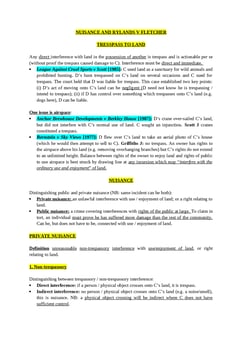Shelfer v City of London Electric Lighting Company [1895] 1 Ch 287
Judgement for the case Shelfer v City of London Electric Lighting Company
Table Of Contents
KEY POINTS
Nuisance is unreasonable interference that disrupts property use or enjoyment, including noise, vibrations, or other disturbances.
Statutory powers are legal authorities granted by laws, enabling specific actions or decisions within defined contexts.
Electric lighting utilizes electricity to illuminate spaces, transforming environments for safety and functionality. Vibration entails mechanical oscillations that can cause structural damage or discomfort, often triggering legal concerns. Noise denotes unwanted sound that disturbs activities or peace, prompting legal action to mitigate its effects. Structural damage refers to impairment in the stability or integrity of buildings, often necessitating legal remedies.
The right of reversioner allows property owners to take legal action to protect future interests upon expiration of current estates.
An injunction is a court order compelling or restraining specific conduct to resolve disputes or prevent harm.
Damages represent monetary compensation awarded to remedy legal wrongs or injuries parties suffer.
Legislative frameworks governing electric lighting provision and regulation, reflecting historical technological advancements.
Jurisdiction practice outlines rules governing court authority and procedures, ensuring fair and effective justice administration.
Time limits for filing appeals are crucial for preserving the right to challenge court decisions within specified deadlines.
Rules of the Supreme Court (1883) Govern the refusal of applications in the Supreme Court, ensuring transparency and fairness in judicial proceedings.
FACTS
In this case, the application of Lord Cairns' Act (21 & 22 Vict. c. 27) allows Courts of Equity to award damages instead of an injunction, though established principles of court intervention still guide injunctions, especially in cases of ongoing nuisance.
-
The Electric Lighting Act of 1882 does not exempt undertakers from liability for common law nuisance resulting from their works.
Section 10 of the Act only applies to construction, not subsequent usage, and section 17 pertains to compensation for damages during construction, not after.
-
An electric lighting company's construction near a leased house caused structural damage and discomfort to the lessee.
The lessee and reversioners filed separate actions seeking injunctions and damages for the nuisance.
Kekewich J. found City of London Electric Lighting Company (“Defendants”) had caused continuous nuisance and structural damage.
Considering the circumstances, relief was granted as damages, not injunctions.
The Plaintiffs appealed against the refusal of injunctions in both actions.
JUDGEMENT
In its judgment, the Court of Appeal allowed the appeal, finding no justification to refuse assistance by injunction for established legal rights.
A. L. Smith L.J. outlined that damages could substitute an injunction under certain conditions, emphasizing fairness to both parties.
The Court clarified that a judgment refusing part of the relief sought by the plaintiff doesn't trigger the appeal timeline under Order LVIII, rule 15.
COMMENTARY
-
This case involves several legal concepts, including nuisance, statutory powers, electric lighting regulation, and the principles surrounding injunctions and damages.
Nuisance, defined as unreasonable interference with property use, is central to the dispute, which is exacerbated by an electric lighting company's construction activities near a leased property.
Despite statutory powers allowing for damages instead of injunctions under certain circumstances, the Court of Appeal emphasized the importance of established principles guiding court interventions, especially in cases of ongoing nuisance.
-
The Electric Lighting Act of 1882, though not absolving undertakers from liability, limits liability and compensation.
Kekewich J. ruled in favor of the plaintiffs, acknowledging the continuous nuisance and structural damage caused by the defendants.
-
The plaintiffs, seeking injunctions, appealed the decision, leading to the Court of Appeal's judgment.
The Court of Appeal allowed the appeal, highlighting the importance of upholding established legal rights and principles.
A. L. Smith L.J. articulated conditions under which damages could substitute injunctions, ensuring fairness to both parties.
Moreover, the Court clarified procedural matters regarding the appeal process, emphasizing transparency and fairness in judicial proceedings.
For Further Study on Shelfer v City of London Electric Lighting Company
Need instant answers? Our AI exam tutor is here to help.
Ask questions 🙋 Get answers 📔 It's simple 👁️👄👁️
Our AI is educated by the highest scoring students across all subjects and schools. Join hundreds of your peers today.
Get StartedSimilar Cases
Related Product Samples
These product samples contain the same concepts we cover in this case.
| Tort Law | Nuisance Notes (70 pages) |

